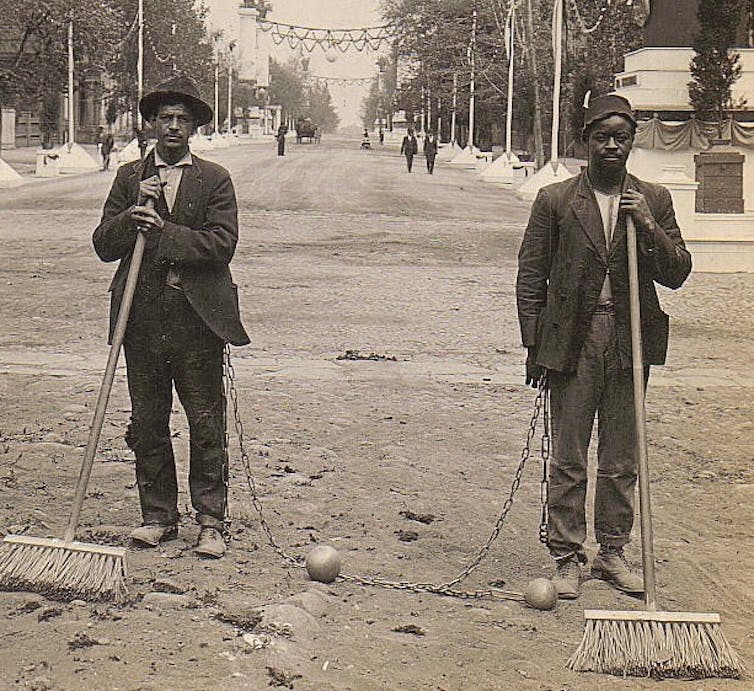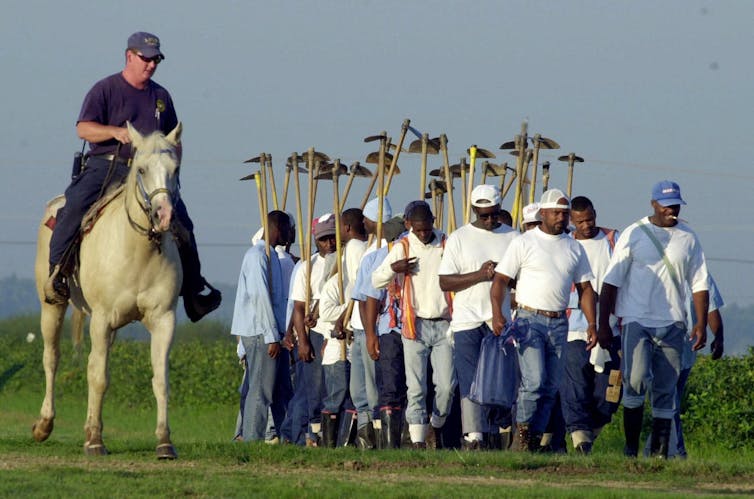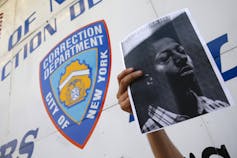Few Americans fully appreciate just how many of their fellow citizens are ensnared in the criminal justice system.
Some may have heard that there are about 2.3 million people behind bars, but that figure tells only part of the story. Yes, in a stunning array of 1,719 state prisons, 102 federal prisons, 901 juvenile correctional facilities, 3,163 local jails and 76 Indian Country jails, as well as in military prisons, immigration detention facilities, civil commitment centers and prisons in the U.S. territories, we physically contain more human beings than any other country in the world. In addition to those actually locked up, there are another 840,000 Americans being supervised on parole and an additional 3.7 million people being monitored on probation.
Consider this: The world’s most populous city, Tokyo, and the U.S.’s most populous state, California, have fewer residents combined than the up to 100 million U.S. citizens who now have a criminal record.
As important, these historically unprecedented rates of containment, and the deep stigma of a criminal record, aren’t experienced equally in this country. America’s incarceration crisis is suffered staggeringly and dis-proportionally by communities of color.
That so many are blissfully unaware of just how many people are, or have been, subject to containment or control is, perhaps, unsurprising. Prisons are built to be out of sight and are, thus, out of mind. Somehow, even though these institutions contain human beings, including children, and even though we are the ones who cough up the billion of dollars that it costs to run them, we are expected simply to trust that they are operated humanely and that they in fact make our society safer.
As a historian of crime and punishment who has been inside of America’s prisons and has documented severe abuses that have taken place within them, I know this trust is not warranted. It is past time that the public has unfettered access to these public institutions so that we can know exactly what happens behind prison walls.
The fight to see inside
There is, in fact, a long history of the public being kept away from prisons so that corrections officials could run them as they wished. For much of the 19th and into the 20th century, state politicians’ deeply ingrained fear of federal encroachment on their power more generally translated into the so-called “hands-off doctrine” when it came to how they ran their prisons. Prison authorities, it was understood, had the right to do what they wanted to those in their charge.
Of course prisoners routinely tried to bring attention to the abuses that happened to them. But time and again, and most notably in the infamous 1871 case Ruffin v. Commonwealth, their bid to be treated as human beings was formally denied. In fact, according to the court in this case, prisoners were “slaves of the state.”

In the 1960s and 1970s, though, in response to escalating protests in penal facilities and in cities across the country, prisoners finally gained some rights. In turn, the public began to learn a bit more about what was happening to them behind bars.
It was, for example, deeply significant when the Warren Court opined in a 1974 case, Wolff v. McDonnell, that
“a prisoner is not wholly stripped of constitutional protections when he is imprisoned for crime. There is no iron curtain drawn between the Constitution and the prisons of this country.”
However, at the moment that more light was being shone on prison conditions because of specific judicial rulings, it was also clear that serious limitations on the public’s access to these institutions would remain and, overtime, actually increase.
In 1974, the court ruled in Pell v. Procunier that prisoners’ First Amendment rights were in fact limited. In this case the court held that journalists, the people who might hear prisoner accounts of abuse and share them with the public, “have no constitutional right of access to prisons or their inmates beyond that afforded to the general public.” As Ted Kennedy noted passionately before his colleagues in the Senate, this decision was alarming since, as he pointed out, “the public cannot regularly tour the prisons and interview inmates.”
Another significant blow to the public’s access came in 1987 when a decision was rendered in the case Turner v. Safley. The court ruled that prisoners’ rights to speak to the media existed only to the extent that prison authorities didn’t have a reasonable justification for restricting those rights. And the lid on access lowered even farther in the 2003 case Overton v. Bazzetta. The court ruled, in short, that if prison administrators wished to bar visitors to prison, their desires trumped other constitutional considerations such as the First Amendment rights of prisoners.
The court even found that prison officials could prevent visits between prisoners and their kids if the restrictions on visitation were related to “valid interests in maintaining internal security.”
Access abroad
Notably, other prison systems, most famously those in countries such as Sweden and Norway, are much more transparent. The primary goal of prison, officials in these countries maintain, is to return people to the society improved. And, thus, they insist, prisons must have oversight to ensure that they are run humanely.
Not only are Scandinavian prisoners assigned a special officer “who monitors and helps advance progress toward return to the world outside,” but Norwegian prisons boast an “explicit focus on rehabilitating prisoners through education, job training and therapy … [and the] priority of reintegration.”
Even in countries not known for their human rights, such as Singapore, prison officials explicitly connect the humane treatment of the incarcerated to the broader public good. As their corrections officials put it, “by rehabilitating our inmates, society can continue to be safe even when these offenders leave prison.”
The principle that the public has a responsibility to run prisons humanely was in fact adopted by the United Nations back in 1955.
When the U.N. revised and again adopted its “Standard Minimum Rules for the Treatment of Prisoners” in 2013, thereafter dubbed the “Nelson Mandela Rules,” not only was it endorsing the idea that penal practices must be humane and prisoners treated like people, but it also made clear that humane treatment depended upon outsider access to prisons. According to the U.N., “services and agencies, governmental or otherwise” interested in prisoners’ well being “shall have all necessary access to the institution and to prisoners.”
Why access matters
Even a cursory glance at our nation’s history indicates that such access is not only desirable, but necessary.
The abuses that went on in this country’s 19th-century penal institutions, both in the North and in the South, are well-documented, and it is now obvious that the 20th century did not bring much improvement.
One need only read of the pain and suffering the men locked up at the Angola Penitentiary in Louisiana endured in the 1950s. Here, men willingly cut their own Achilles tendons so that they might avoid the abuses of the guards driving them in the prison’s cotton fields. Or we can look at the horrific torture endured by the men at Attica in the wake of their 1971 protest.

Throughout American history unspeakable abuse of men and women has been allowed to happen behind prison walls because the public had no access.
And, if we pay close attention to what has been happening much more recently behind bars, it is clear that the closed nature of prisons remains a serious problem in this country.
In September 2016, prisoners at facilities across the country erupted in protests for better conditions. In March and April of 2017, prisons in Delaware and Tennessee similarly exploded.
In each of these rebellions, the public was told little about what had prompted the chaos and even less about what happened to the protesting prisoners once order was restored.

In fact, when we, the public, just dig a little, it is obvious that much trauma takes place behind bars while we aren’t watching.
In a juvenile facility in Florida it is now clear that over the course of many decades in the 20th century, prison officials murdered scores of young boys. In facilities such as Rikers Island, young people today experience physical abuse and some have died in custody. And not just children, but vulnerable adults as well, suffer tremendously, and daily, because they are at the utter mercy of officials who don’t have to answer to the public.
Indeed, it is only when there is a particularly dramatic abuse, or a death that simply can’t be hidden, that the public gets any glimpse of what life on the inside is like for so many Americans.
It wasn’t until concern was raised about babies being born with brain damage that we learned that women are shackled during childbirth in our prisons. It wasn’t until brave health care professionals came forward that we learned about the many broken bones and internal injuries prisoners were suffering at the hands of their captors. It wasn’t until prisoners ended up dead with marks on their body indicating to outside coroners that they had been tortured that we knew about the traumas that the mentally ill are suffering in prison. And, sadly, it isn’t until we hear of cases being filed on behalf of children that we finally learn how many of them have suffered sexual and physical abuse and about how much emotional distress they suffer from being kept in utter isolation.
More recently, until journalist Nell Bernstein managed to get access to our nation’s juveniles facilities, the public was blissfully unaware of the alarming fact that “More than a third of youth reported that staff used force unnecessarily, and 30 percent said that staff placed them into solitary confinement as discipline,” or that the amount of physical forced used on children in these facilities is “staggering.”
Here is but one account that Bernstein was able to share with the public of a 12-year-old boy who, when his mother was allowed finally to visit him, was found “rail-thin,” with his eyebrows shaved off, a dent in his temple and with a “huge black eye, a busted lip, and a bruise on his rib cage in the shape of a boot.” When she asked him, appalled, how he had gotten so injured he explained flatly, “Mom, this is what happens…A guard did this. They want you to know who’s boss.”
Volatile and dangerous workplaces
It isn’t just those who have been sentenced to serve time in prisons who suffer from the public’s lack of access to those institutions. The men and women who work inside of them also pay a high price.
Every American prison is, of course, severely overcrowded and, therefore, they are not just hellholes for the incarcerated, they are also volatile and dangerous workplaces.
Like prisoners, correction officers also end up injured and killed behind bars and, also like prisoners, they too experience high rates of suicide as a result of the terrible conditions. And, also as with prisoners, the only way we hear just how terrible things really are for guards is when something particularly awful happens to one of them and protests erupt, as they did in states such as Alabama in 2016.
Barriers to access
When ordinary citizens learn of atrocities committed behind bars, most are appalled, but the sad reality is that the public actually has few legal tools at its disposal to insist on the access it needs to protect guards or prisoners.
Yes, the American public does have some “right to know” what the officials we pay are doing via the 1966 Freedom of Information Act (FOIA). This piece of legislation was intended to facilitate “the watchdog function of the public over the government” and it was meant to give citizens “the knowledge necessary to evaluate the conduct of government officials.” All who supported the passage of FOIA understood that “access to the government information necessary to ensure that government officials act in the public interest.”
When one group tried to get documents from the Bureau of Prisons, for example, it was denied access to files for 14 years and, even then, it took a law suit to settle the matter. As journalist Jessica Pupovac points out, “Restrictive prison policies continue to be an issue – and a problem – for journalists.” Of course, for those without press credentials, finding out what is happening behind bars – having any idea what behaviors and actions their tax dollars are making possible in America’s vast carceral network – remains virtually impossible.
How then might Americans ever know what actually goes on in the criminal justice system that they fund, the penal institutions that their loved ones populate in ever greater numbers and in the many other apparatuses of containment they are told will keep them safer?
The answer to that question is not at all clear, but the imperative of continuing to loudly demand public access to our public penal institutions is. Access is a responsibility even if it has yet to be a guaranteed right.
As history and present-day headlines make clear, the public must know what happens in prisons. Not knowing is what makes it possible for unimaginable suffering to take place in the name of safety and security. There is no reason for us to make this Faustian bargain, and countless, human, reasons why we must not.

